Читать книгу Adhesives for Wood and Lignocellulosic Materials - R. N. Kumar - Страница 58
2.6 Diffusion Theory
ОглавлениеThe diffusion theory was proposed in the early 1960s by Voyutskii [17–19]. It states that the intrinsic adhesion of a resin to a polymeric substrate is due to mutual diffusion of polymer molecules across their interface.
As a result of this interdiffusion of molecules of the adhesive and adherend, their interface disappears. Hence, the diffusion theory is applicable only when both adhesive and adherend are compatible polymers that possess sufficient mobility and mutual solubility. Solvents or heat welding of thermoplastic substances is caused by diffusion.
The prerequisite of the diffusion theory is that the polymers of the adhesive and of the substrate should possess similar values of solubility parameters.
Several problems are encountered when an attempt is made to apply the diffusion theory to wood. Basically, wood is not homogeneous in composition. It is a cellular composite of three polymers, namely, cellulose, hemicelluloses, and lignin. Furthermore, cellulose consists of both crystalline and amorphous regions. It is clear then from solubility parameter concepts that some polymers, the amorphous ones such as hemicelluloses and lignin and the amorphous portion of cellulose, could, under some conditions, undergo mutual diffusion with the polymer chains of the synthetic adhesives. The crystalline portion of cellulose is not likely to be involved.
There is one specific instance in the case of wood adhesion [17] in which interdiffusion appears to exist and is likely to play a significant role in wood bonding. This is the production of fiberboard by the wet process in which no adhesive is added. At high moisture content, high temperature and pressure and long pressing times, the glass transition temperatures of lignin are exceeded. Thus, the lignin in the fibers is mobilized and the interdiffusion between lignin polymers on different fibers contributes to the bonding of the fibers together.
